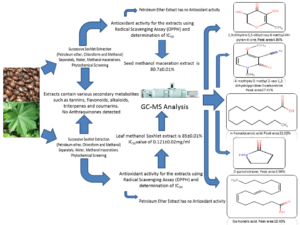(1) Department of Chemistry, Faculty of Science and Technology, Alneelain University, Khartoum, Sudan,
(2) Department of Scientific Laboratories (Chemistry), Faculty of Science, Sudan University of Science and Technology, Khartoum, Sudan
* Correspondence to: hanibushra10@yahoo.com
 The study investigates phytochemicals and antioxidant potential of leaf and seeds extracts of Ricinus communis L. Ricinus communis L. commonly known as castor plant belongs to the family Euphorbiacea. Phytochemical screening showed that both seeds and leaves of Ricinus communis L. have various secondary metabolites such as: tannins, flavonoids, alkaloids, triterpenes and coumarins, while anthraquinones were not detected. Antioxidant potentials were assessed on the basis of radical scavenging effect of the stable 1,1-diphenyl-2-picrylhydrazil (DPPH). Leaf methanol Soxhlet extract showed the maximum antioxidant activity (85±0.01%) with IC50value of (0.121±0.02mg/ml). Seed methanol maceration extract showed high antioxidant activity (80.7±0.01%) while petroleum ether extracts of both leaf and seeds showed no antioxidant activity. Spectroscopic analysis using GC-MS of the methanol maceration extract of leaf showed the presence of various compounds such as n-hexadecanoic acid with the highest peak area 22.02%, 4-methoxy-1-methyl-2-oxo-1,2-dihydropyridine-3-carbonitrile with peak area 17.41%, gamonelic acid with peak area 10.40%, 2,3-dihydro-3,5-dihydroxy-6-methyl-4H-pyran-4-one with peak area 4.84% and 2-pyrrolidinone with peak area 3.98%.
The study investigates phytochemicals and antioxidant potential of leaf and seeds extracts of Ricinus communis L. Ricinus communis L. commonly known as castor plant belongs to the family Euphorbiacea. Phytochemical screening showed that both seeds and leaves of Ricinus communis L. have various secondary metabolites such as: tannins, flavonoids, alkaloids, triterpenes and coumarins, while anthraquinones were not detected. Antioxidant potentials were assessed on the basis of radical scavenging effect of the stable 1,1-diphenyl-2-picrylhydrazil (DPPH). Leaf methanol Soxhlet extract showed the maximum antioxidant activity (85±0.01%) with IC50value of (0.121±0.02mg/ml). Seed methanol maceration extract showed high antioxidant activity (80.7±0.01%) while petroleum ether extracts of both leaf and seeds showed no antioxidant activity. Spectroscopic analysis using GC-MS of the methanol maceration extract of leaf showed the presence of various compounds such as n-hexadecanoic acid with the highest peak area 22.02%, 4-methoxy-1-methyl-2-oxo-1,2-dihydropyridine-3-carbonitrile with peak area 17.41%, gamonelic acid with peak area 10.40%, 2,3-dihydro-3,5-dihydroxy-6-methyl-4H-pyran-4-one with peak area 4.84% and 2-pyrrolidinone with peak area 3.98%.
Ricinus communis L., antioxidant activity, phytochemical screening, IC50, GC-MS